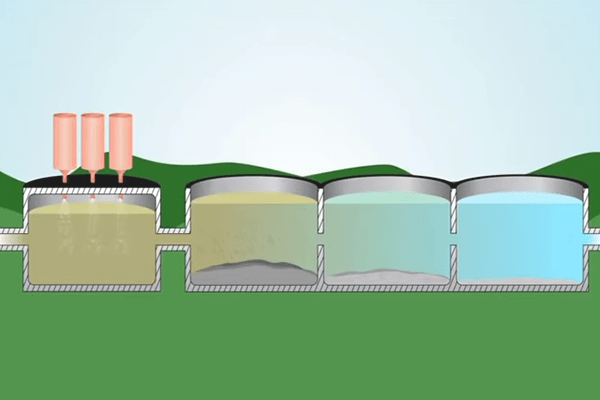A simple house has several advantages—reduced cost, easier maintenance, and a compact, well-utilized space. But it also has its disadvantages. For one thing, there’s not enough room for large water treatment systems, which could be a challenge if you live in an area with a poor water supply.
Fortunately, there are effective water treatment methods for simple houses. We’re ready and happy to share them with you in this post!

Contents
How to Treat Water in a Simple House
The key to treating water in a simple house is to choose the treatment method that takes up as little space and energy as possible. Some of these methods include:
Water Filtration
Water filtration involves passing water through a membrane or barrier to remove contaminants. It’s a very effective way of removing sediments, microbes, and chemicals from water. You can treat your water using any of these point-of-use filters:
- Water pitchers: Pitchers are small jugs designed to filter and store water. They take up less space, so you can use them in a simple home.
- Faucet filters: These are simple water filters you can fix on your taps to filter water as it flows out.
- Countertop units: You can place a countertop unit on your kitchen cabinet and attach it to your water tap to filter the water that comes out.
Water Softening
Hard water can damage your clothes, home surfaces, and appliances. You can treat hard water in your home by using a water softener. Water softeners work to remove minerals that make your water hard. There are different types of water softeners. Some are salt-based, meaning they remove hardness-causing minerals and replace them with salt. Others are salt-free and do not add salt to your water.
A magnetic descaler uses magnetism to neutralize hard minerals in the water. It is usually small-sized and practical for a simple home. Magnetic softeners are easy to install and do not take up a lot of space, although they may not be as effective as salt-based softeners. You can choose the best type for your simple home by checking out softener reviews.
Chlorination
You can also treat the water in your simple home by adding chlorine. Chlorine is a chemical that can neutralize microorganisms in water. You can add chlorine to your water by using household bleach or chlorine tablets.
Household bleach contains chlorine as the main ingredient. It is safe to use for drinking water as long as the bleach is unscented and the manufacturer’s label says it’s okay for disinfection. You should add two drops of bleach per liter and wait 30 minutes before using your water.
Chlorine tablets are ready-made tablets for disinfecting water. To disinfect your water with chlorine tablets, use 1mg chlorine tablet per liter and wait 30 minutes before using your water.
UV Purification
Another water treatment option for simple homes is UV light purification. This method is simple, easy to use, and appropriate if your water contains many microorganisms. All you need is a UV light source to pass through your water. UV light is powerful and destroys most microorganisms, including those that chlorine cannot destroy. There are two practical ways you can use UV purification in your simple home:
- UV purification pen: this is a simple pen-like device with a UV bulb at one end. You can buy these pens and insert one into your water container just before you use your water. To purify your water, stir your water with the pen for about a minute.
- UV treatment systems: These are water systems you can install at your point of water entry. They contain a UV lamp that neutralizes microorganisms as water passes through the system. There are different sizes of UV systems for residential homes, so you can buy one that fits your simple home.
Neutralization
If your simple home’s water is acidic, you should neutralize it so that it does not damage your appliances and encourage toxic contaminants to leach into your water. There are two ways you can do this:
- Use whole-house acid neutralizers: if your home’s plumbing has enough space to install a whole-house system, you should install an acid neutralizer. Acid neutralizers work by introducing calcite (a highly alkaline mineral) into your water to balance its pH. This neutralizes your water before it even enters your home.
- Use chemical injection systems: you can also use a pump that injects soda ash into your water at the source. Soda ash is highly alkaline, making your water’s pH neutral. The downside is these systems can be challenging to maintain and expensive, so you may not want to consider them unless your water is very acidic.
More on LivingProofMag
Water Coming Up From Basement Drain After Rain
The Importance of Water Conservation At Home
9 Signs You Need Sewer Line Repair
Solar Disinfection
If you’re a fan of all-natural methods, you can use solar disinfection in your simple home. This method uses natural UV light from the sun to treat water. Here’s how to do it:
- First, pour your water through a clean cloth that has tiny pores. These pores will filter out large particles.
- Pour the filtered water into clean water bottles.
- Get a dark cloth or any other dark surface and lay the bottles on it under direct sunlight.
- Leave the bottles there for about six hours if it’s very sunny. If it’s not a sunny day, you may have to wait about 48 hours.
- Pack the bottles in and enjoy clean, treated water.
Your simple house will be a joy to live in when you can access safe drinking water. If you want safe water in your home, use our guide to choose a treatment method that applies to you. It’s best to do a water test before selecting a treatment method. When you know the exact type of contaminants in your water, treating water in your simple home becomes easier.
